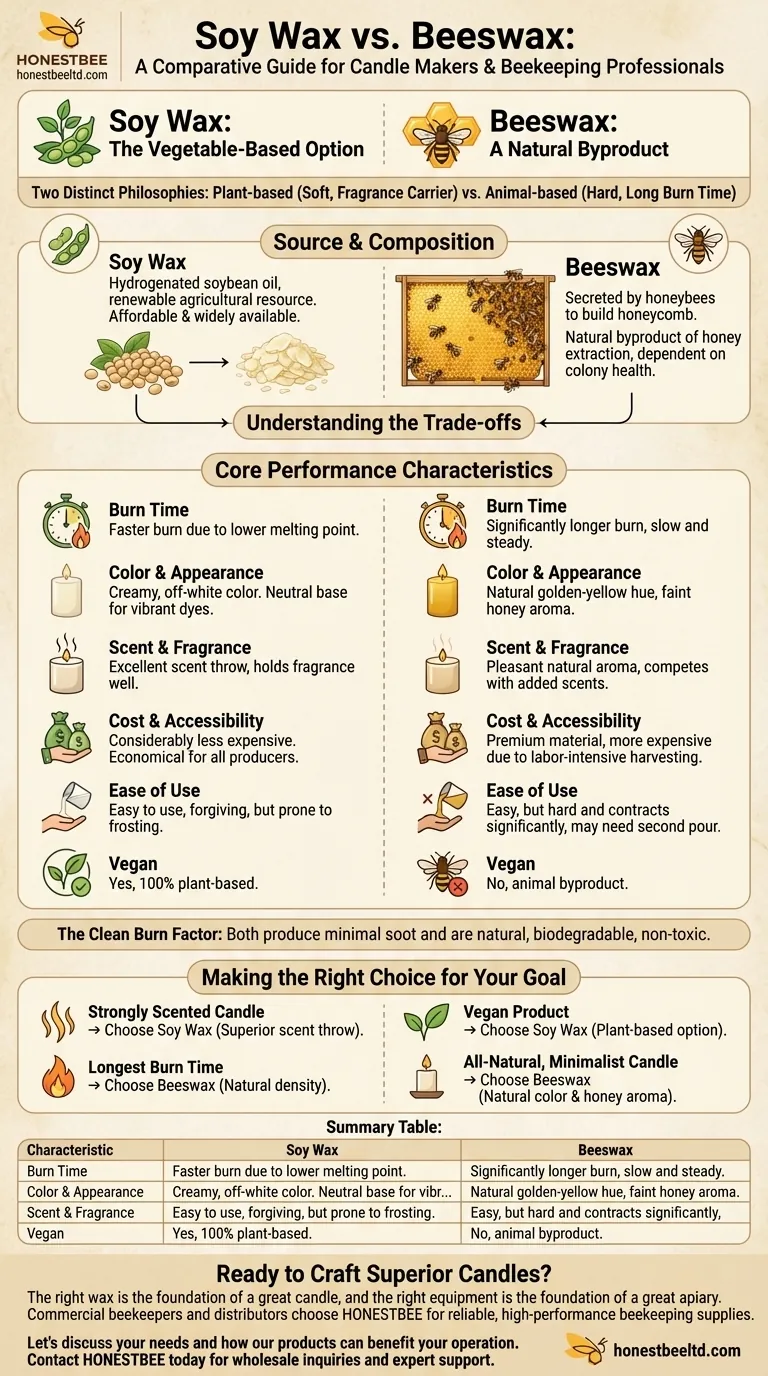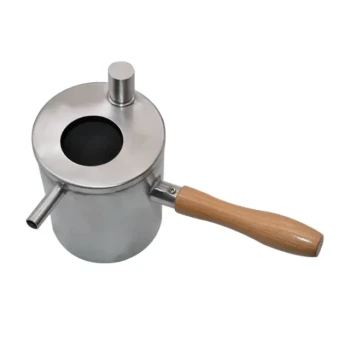At their core, soy wax and beeswax represent two distinct philosophies in candle making. Soy wax is a soft, vegetable-based wax derived from soybeans, prized for its ability to carry fragrance. Beeswax is a hard, dense wax produced by honeybees, renowned for its exceptionally long burn time and natural, subtle honey aroma.
The choice between soy and beeswax is not about which is superior overall, but which is best suited for your specific goal. Soy wax excels as a versatile base for scented candles, while beeswax shines as a premium, natural material for long-lasting, minimalist candles.

Source and Composition: Plant vs. Animal
The most fundamental difference between these two waxes lies in their origin, which influences their properties, cost, and ethical considerations.
Soy Wax: The Vegetable-Based Option
Soy wax is a hydrogenated form of soybean oil. As a vegetable-based wax, it is a renewable resource.
Its creation from a major agricultural crop generally makes it more affordable and widely available than beeswax.
Beeswax: A Natural Byproduct
Beeswax is a natural wax produced by honeybees. It is secreted by glands on the bees' abdomens to construct the honeycomb.
It is harvested as a byproduct of the honey extraction process, making its supply dependent on the health and productivity of bee colonies.
Core Performance Characteristics
How a wax behaves in a candle—from how long it burns to how well it smells—is determined by its physical properties.
Burn Time
Beeswax has a higher melting point and is denser than soy wax. This causes it to burn more slowly and for a significantly longer duration.
Soy wax has a lower melting point, which contributes to a faster burn but also helps it release fragrance more effectively.
Color and Appearance
Soy wax is naturally a creamy, off-white color. This provides a neutral, consistent base that readily accepts dyes for vibrant color creations.
Beeswax has a natural golden-yellow hue and a faint, sweet scent of honey. While it can be filtered to a white color, many artisans prefer its natural state.
Scent and Fragrance
Soy wax is known for its excellent scent throw, meaning its ability to hold and release fragrance oils into a room. Its lower melting point creates a larger pool of melted wax, which helps diffuse the scent.
Beeswax has its own pleasant, natural aroma. This inherent scent can compete with or alter added fragrances, making it better suited for unscented candles or those using complementary essential oils.
Understanding the Trade-offs
Choosing a wax involves balancing benefits with potential challenges in both cost and crafting.
Cost and Accessibility
Soy wax is considerably less expensive than beeswax. Its production from a large-scale agricultural crop makes it an economical choice for both hobbyists and large-scale producers.
Beeswax is a premium material. The process of harvesting it from beehives is more labor-intensive, making it one of the most expensive candle waxes on the market.
Ease of Use
Both waxes are considered easy for beginners to work with. They melt easily and are generally forgiving.
However, soy wax is softer and can sometimes be prone to "frosting" (white crystalline formations on the surface). Beeswax is very hard and contracts significantly as it cools, sometimes requiring a second pour to achieve a smooth top.
The "Clean Burn" Factor
Both soy wax and beeswax are considered "clean burning" because they produce significantly less soot than traditional paraffin wax.
They are both natural, biodegradable, and non-toxic options, providing a healthier burn for both you and the environment.
Making the Right Choice for Your Goal
To select the correct wax, first define the most important characteristic of your finished candle.
- If your primary focus is a strongly scented candle: Choose soy wax for its superior ability to hold and release fragrance oils.
- If your primary focus is the longest possible burn time: Choose beeswax for its natural density and slow-burning properties.
- If your primary focus is creating a vegan product: Soy wax is the only plant-based option between the two.
- If your primary focus is an all-natural, minimalist candle: Choose beeswax to leverage its beautiful natural color and subtle honey aroma.
Ultimately, understanding these fundamental differences empowers you to select the wax that perfectly aligns with your creative vision and performance expectations.
Summary Table:
| Characteristic | Soy Wax | Beeswax |
|---|---|---|
| Source | Plant-based (Soybeans) | Animal-based (Honeybees) |
| Best For | Strongly scented candles | Long-burning, natural candles |
| Burn Time | Good | Excellent (Longer) |
| Scent Throw | Excellent | Good (with natural honey aroma) |
| Cost | Affordable | Premium |
| Vegan | Yes | No |
Ready to Craft Superior Candles?
The right wax is the foundation of a great candle, and the right equipment is the foundation of a great apiary. Just as you choose between soy and beeswax for specific results, commercial beekeepers and distributors choose HONESTBEE for reliable, high-performance beekeeping supplies.
We supply the essential tools that help you produce premium beeswax and honey efficiently and sustainably. Whether you're a large-scale commercial apiary or a beekeeping equipment distributor, our wholesale-focused operations are designed to support your success.
Let's discuss your needs and how our products can benefit your operation.
Contact HONESTBEE today for wholesale inquiries and expert support.
Visual Guide

Related Products
- Beeswax Melter for Candle Making Honey Bee Wax Melter
- Steam Beeswax Melter Wax Warmer for Wax Processing
- Electric Honey Press Machine for Squeezing Honey Comb Press Equipment
- Stainless Steel Honey Press Wax Press with Tank
- Long Langstroth Style Horizontal Top Bar Hive for Wholesale
People Also Ask
- What is the best way to melt beeswax for candles? The Safest Method for Professional Results
- What is the recommended temperature range for melting beeswax? Achieve Perfect Quality & Safety
- What makes polyurethane foam environmentally friendly? The Surprising Benefits of a Durable, Inert Material
- What is the flashpoint of beeswax? Essential Safety and Quality Tips for Beekeepers
- How do water jacket melters function? Achieve Gentle, Scorch-Free Melting for Sensitive Materials



















